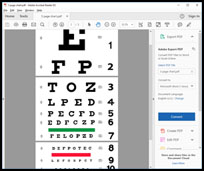If you have natural healthy vision, your eyes are constantly making tiny movements (called saccades) to scoop up many different light waves. Then these are converted to electrical signals and transferred to the brain, to paint a rich full picture for you to see. Eyeglasses train the eye not to move, unfortunately. The strongest correction is in the center of each lens, so you learn not to deviate too far from that, in order to see the most clearly through your glasses. And you don’t want to look too far to the side or up or down either, because you’ll run into the visual wall of the frames.
When people start vision improvement and first practice seeing without glasses, they often retain this staring habit. Their eyes have learned not to move, and they need to re-learn to let their eyes easily travel around the scene in front of them. A related problem with glasses is that they teach you to see a large area all at once, to not look for smaller details. It’s as if you’ve let your brain think a computer screen is one giant pixel containing the entire view on the display, and you don’t have to look around at all. NO! Each tiny pixel is different, with different information, and you have to look at each one to get all of the visual data.
OK, does that mean you have to look at every single pixel, one at a time? Of course not! The idea is to focus on smaller details, maybe word-sized or letter-sized at first, and keep your gaze moving. Not frantically, but easily, in a slow gentle way. Experiment with it, making it a game, letting it be play, not work. See how your eyes like it. Do they feel more relaxed? Staring, or NOT moving your gaze, is very stressful to the visual system. Think how stiff your body gets when you don’t move for a while. The eyes were designed to keep moving, just like the rest of you.
A friend who wears thick glasses herself told me she had discovered her pre-teen son needed glasses. She said when he first put them on, he exclaimed, “Wow! That bush outside the house is made up of lots of small leaves — I thought it was just a green blob!”. My heart ached for this boy, and I realized that could have been me years ago. I did not know how to look at details at all. I’d take a visual gulp of information, then stop looking at anything until the next gulp which could be many seconds later. I regret to say my brain was only minimally engaged in my seeing. Looking back, I think I didn’t really want to connect with the outside world then, and my visual habits showed it.
Sometimes a fear factor comes into play here too. If a person is anxious, she may think she has to look at everything at once, in order not to miss something. I’ve heard people say “If I take time to look at details, I might not see the danger coming!” or even “Something could get me!”. When you start vision improvement you may find that you have to look around more slowly at the start, as you develop your new better habits of seeing, but you’ll quickly find you can see MORE than you did with glasses. This may happen in spurts at first, but it is so exciting and empowering!
When I started noticing the screen mesh every time I looked out the window, even from half-way across the room, I was annoyed initially. I didn’t want this interfering with my view of cars and trees and interesting, relatively distant, objects to scan. Then I realized it meant I was seeing more detail! Great! I feel the same way about the pixels on my computer screen now — it’s fantastic that I can see this level of detail, which I’m sure would give me a headache if I were still wearing glasses. It also means I should probably move back from the screen a bit!
More and more, I am enjoying looking at small details, at all distances, and am appreciating my eyes for giving me the ability to do so. Behind my house is a little tree with vivid yellow leaves right now in late autumn, and when the sun hits it, it almost glows. Where before I used to just appreciate the color, now I scan over the individual leaves, feeling like I could count them, a much richer experience than gulping the entire tree at once. The heavy rain of the past few days has pulled off a lot of the leaves, so when the sun comes out again it won’t be a glowing ball any longer, just separated glowing specks. Yet the individual leaves are actually easier to see now. And there are always endless details to scan in the woods.
So how about observing yourself, to see if you’re trying to see everything at once, making do with a Cliff Notes version of what’s there? Gently let yourself notice the details, and how much richness is in your view — it’s the difference between a tapestry and a flat bedsheet! Enjoy all the minutiae, the varying hues and shadings and textures. The more gently and curiously you look around, the more visual information will be revealed to you. Savor every speck!
I wore strong glasses, then contact lenses, from age 5 into my 40s. While making many mistakes, eventually l learned how to improve the way I use my eyes and to see in a more relaxed, healthy manner. It is my pleasure to coach others to do the same. Visit me at https://NancyLNeff.com.

